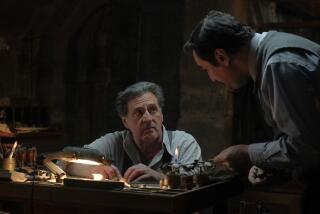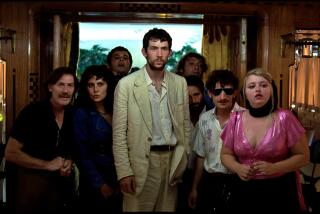‘Camille Claudel 1915’ with Juliette Binoche revisits artistic torment
Seventy years after her death in a mental hospital where she had lived for the last three decades of her life, French sculptor Camille Claudel continues to fascinate even if her artistic talent is obscured by her madness and her work exists perpetually in the shadow of her mentor and ex-lover, Auguste Rodin.
“Camille Claudel 1915,” directed by Bruno Dumont and starring Juliette Binoche, is the latest dramatic portrayal of the psychologically troubled artist. The movie, which opens Friday in Los Angeles, focuses on just three days in the artist’s life during her stay at a psychiatric institution in Montdevergues in the south of France.
As with Dumont’s other films, “Camille Claudel 1915” is stylistically ascetic and narratively anti-dramatic. Claudel spends her time waiting for a visit from her brother, the Christian writer Paul Claudel (Jean-Luc Vincent). Her days consist of little more than meals, walks and interactions with other patients.
Binoche is the star of the movie, but the real casting coup is the use of actual patients to play some of Claudel’s fellow sufferers. Dumont cast patients (and caretakers) from Saint Paul de Mausole, the institution in the south of France where Vincent Van Gogh stayed for 12 months in 1889-90, and where he created numerous works of art.
The movie portrays Claudel as profoundly unhappy and suffering from paranoid delusions, believing that Rodin and his supporters were still plotting against her and trying to poison her food. The movie’s few glimmers of optimism come from the other patients, including one (Alexandra Lucas) whose friendly overtures are cruelly rebuffed by the self-centered Claudel.
Pitiless but also spiritually attuned, “Camille Claudel 1915” concludes with a terse epilogue to its heroine’s life: “Camille Claudel will spend the last 29 years of her life in this asylum, where she will die on the 19th October 1943, at the age of 79. Buried in a communal grave, her body will never be found.”
Here are three other works about Claudel that take a more expansive approach to the artist’s life and career.
“Camille Claudel”: Isabelle Adjani received an Academy Award nomination for her performance in Bruno Nuytten’s melodramatic take on Claudel’s life. The sweeping movie, which was released in the U.S. in 1989, covers her rise to prominence and her stormy relationship with Rodin (Gérard Depardieu), culminating with their violent break and her incipient madness.
“Rodin”: Despite its title, Boris Eifman’s ballet, which came to City Center in New York in March and the Segerstrom Center for the Arts in Costa Mesa in May, spends much of its time with Claudel, depicting her creative process and her time in the asylum. Here is The Times’ review of the production by critic Lewis Segal.
“A Room of One’s Own”: Among the handful of biographies on Claudel, this 2002 volume by Odile Ayral-Clause attempts a comprehensive portrait of the artist’s life, including the many years she spent in Montdevergues. From a Times review: “By excavating Claudel from the edifice of victimization, Ayral-Clause frees us to focus on her work and the factors, both Rodin- and non-Rodin-related, that nurtured and hindered her career.”
ALSO:
Review: The collateral damage of genius in Boris Eifman’s ‘Rodin’
Edvard Munch’s “The Scream” goes for $119.9 million at Sotheby’s
Claude Monet painting fetches $30.8 million in auction bidding battle
More to Read
The biggest entertainment stories
Get our big stories about Hollywood, film, television, music, arts, culture and more right in your inbox as soon as they publish.
You may occasionally receive promotional content from the Los Angeles Times.







